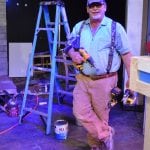Theatrikos volunteers Larry Gould and Raymond Michalowski contemplate the purpose and complexity behind modern stage sets.
Actors do not need a stage set
By Larry Gould and Raymond Michalowski
Actors do not need a stage set, they only need a stage and their lines. The Greeks valued the power of the spoken word. Their main method of communicating values, beliefs and world view, as is the case today, was through storytelling. The Greeks did not need a stage set to tell the story. They performed, often from early morning to late evening with an orchestra on a platform that averaged 78 feet in diameter with no adornment. While the theaters were built on a very large scale, holding up to 14,000 people, the acting, not the stage set carried the day. In most cases the mask was the only prop. Masks enabled an actor to appear and reappear in several different roles, thus preventing the audience from identifying the actor to one specific character. Their variations helped the audience to distinguish sex, age, and social status, in addition to revealing a change in a particular character’s appearance, e.g. Oedipus after blinding himself. There were however no stage sets as we think of them today.
Scenery or “stage sets” did not become common until the Roman times and became even more so in the Germanic and Scandinavian theater after the fall of the Roman Empire. It should be noted that stage sets were very common in Asian theater; however, this did not have a direct impact on so-called Western Theater.
Our modern notion of scenery or stage sets dates back to the 19th century and finds its origins in the dramatic spectacle of opera buffo. It was felt at the time that the actor(s) carried the play, not the background in which they acted. A simple stage was all that was necessary, whether it be in a theater or from the gate of a wagon. As time progressed, elaborate settings were appropriated by the ‘straight,’ or dramatic, theatre, through their use in comic operettas, burlesques, pantomimes and the like.
Some might say that as the imagination of the audience waned, stage settings grew more realistic, reaching their peak in the Belasco realism of the 1910-20s, in which complete diners with working soda fountains and freshly made food were recreated on stage. There is much debate about the change. Did sets become more elaborate because imagination waned, or did imagination wane because sets were more elaborate. Perhaps as a reaction to such excess and in parallel with trends in the arts and architecture, in the 1930s scenery began a trend toward abstraction, although realistic settings remained in evidence and are still used today.
Modern stagecraft has now grown so complex as to require, on large thematical production, the highly specialized skills of hundreds of artists and craftspeople to mount a single production. There is nothing, however, that can replace good acting. No set, no scene, no theater can create wonderful lines, delivered by great and even good actors.
It should be noted that construction of theatrical scenery is frequently one of the most time-consuming tasks when preparing for a show. As a result, many theatres have a place for storing scenery so that it can be used for multiple shows. Since future shows typically are not known far in advance, theatres will often construct stock scenery that can be easily adapted to fit a variety of shows.
There are at least four parts to creating a “set.” Concept, construction, autistics and props. Concept refers to the dreams of the director modified by the reality of the engineering and the laws of physics. These are most often applied by the technical director. Construction includes the design of the set and the placement of flats, platforms and other things of a structural nature. Construction also includes issues of safety for the actors and something called a budget. Autistics involves painting, trim, lighting and sound. Props are what make a set look authentic to the time and place. It all comes together in a partnership between the technical director, the director and stage manager.
So, where does it start? A flat? A platform? A design? Glue? Screws? Staples? Wood? A chair? A table? Most importantly it starts with a sharing of imagination between the director and the technical director. This of course is followed by skill and safety, as well as the art of compromise. A set creates, for the audience, a sense of time, space, and place. It creates a mood, a sense of being and ambience that supports the actors. A set can be a kind of a silent act in its own way, but only if it serves to deliver the message of the play.
In sum. A set is nothing more than a physical entity that supports the imagination of the audience in their attempt to understand and/or enjoy the message of the production. It has a role, it has a place, it sends a message, it creates an environment, but without the actors it is just a space. It is just wood, glue, paint, screws, staples and imagination. It is an empty and incomplete space in search of the energy, vitality and the interpretation of the actors.
Actors do not need a stage set, but then ice cream without a topping is just ice cream.

